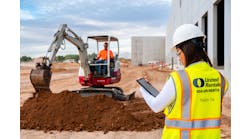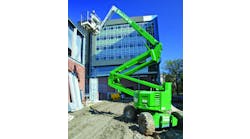When the mercury starts dropping in the fall, general contractors and construction managers must maintain proper temperature, relative humidity and ventilation on their jobsites. Temporary heating and ventilating equipment and services are an important and necessary part of the solution to keep jobsites running smoothly throughout the winter months.
During the construction process, thousands of gallons of water are used in the construction of most commercial buildings. Concrete mixtures, masonry, drywall compound, fireproofing, paint, floor coating and varnishes all begin using a water base. When the finishes dry, the moisture is given up into the interior spaces of the building. Knowing this, it is as important to keep the building ventilated and dry as it is to maintain comfortable temperatures.
There are advantages to choosing the correct temporary heating equipment for an application. For example, direct-fired make-up air heaters may be the best choice for providing a system of both heat and ventilation in an enclosed building. However, smaller propeller fan, tube-style heaters are best suited for work in temporary poly or canvas enclosures. The following is an overview of different types of heating equipment and their applications.
Direct-fired make-up air heaters
Fossil fuel burning equipment is categorized as either “direct fired” or “indirect fired.” Direct-fired heaters do not have a heat exchanger for the exhaust gases, and all products of combustion go into the space being heated. Direct-fired heaters can be very fuel-efficient since no energy goes up a chimney. Nationally recognized testing laboratories approve this type of equipment for multiple applications since it is very clean burning.
Make-up air heaters should be installed to draw 100-percent outside air for proper heat distribution and ventilation of the construction processes. High-cubic feet per minute (CFM), low-temperature discharge units typically feature a centrifugal-style blower wheel and an electronic modulating gas control system for maximum fuel efficiency and inside temperature and humidity control. The lower discharge temperatures of these units will mix better with internal air and reduce heat stratification. To provide reasonable heat retention, these units are best used when the walls and roof are in place, and windows and doors are either installed or covered with a double poly system.
Direct-fired tube-style heaters
Tube-style, portable prop fan heaters, also known as salamanders or torpedoes, are typically used for heating masonry enclosures or under concrete deck pours where high temperatures and portability are necessary for these high-heat-loss temporary structures. These will typically have lower fan induction ratios and higher discharge temperatures, best suited for heating concrete pours where heat stratification is desired. They are also useful in other temporary enclosures because of their portability and lower voltage requirements.
Indirect-fired heaters
Indirect-fired construction heating equipment is similar to a system used in a house, but on a much larger scale. This equipment uses a heat exchanger in the air handler and a flue to exhaust the burned gas. Design of these units has improved significantly over the years, offering higher efficiencies. Compared to direct-fired equipment, however, these units will still burn more fuel on comparable inputs. Indirect-fired heaters are also much more expensive to build, making purchase costs and rental rates higher.
Most indirect-fired heating equipment will have higher CFM and lower discharge temperatures similar to make-up-air equipment. These units should also be equipped with remote inside temperature sensing for fuel management. There are many good units on the market, and they can be a good option for specific applications where this type of equipment is required or specified.
Electric heaters
Construction projects that have a lot of power available will occasionally look at using portable electric heaters. Under normal conditions, a construction site can be heated more economically with natural gas or propane, but with fossil fuel costs continually rising, more companies are giving electric heaters a second look. In the past, electrics were mostly used in non-construction areas such as power plants, manufacturing or assembly plants, utilities, government facilities and other industrial applications.
Portable electric heaters can range from 115V, 1,000 watt to 480V/600V, 150 kW and larger. Because there are no products of combustion, electric heaters are usually installed inside the heated space, and the inside air is re-circulated.
Steam and hot water heaters
Steam and hot water heaters can be used when a permanent steam or hot water plant is accessible. A temporary steam unit uses a coil and fan air handler component section to produce heat. The steam or hot water is piped into the coil while the air passing through the coils is heated and then introduced into the desired areas of the building through air handlers. The steam condenses to water and is sent back through return lines to the boiler to start the process over again. If hot water is used instead of steam, the water is pumped back in return lines and reheated by the boiler as necessary.
Steam and hot water units commonly re-circulate the air in the space they are heating. Using outside air to provide a system of controlled ventilation is possible, however, precautions would need to be taken to protect coils that could be exposed to freezing conditions in the event of a boiler failure. This is typical of permanent installations, but some advanced planning is needed to be successful.
GROUND THAWING
Ground thaw units are typically used during the early stages of construction when the ground needs to be thawed to dig for footings and foundations. Most systems are enclosed in a trailer and consist of a glycol-filled boiler operated on diesel, or natural or propane gas. Pumps and reels of heat transfer hose provide distribution in lengths of about 1,500 lineal feet per reel. The hose is laid out in a serpentine fashion over the ground with anywhere from 12 to 16 inches between the hoses. Concrete curing blankets are placed over the heat transfer hoses and the boiler and glycol circulating pumps are started. The heated glycol circulates through the hoses and the heat radiates into the frozen ground. Frost can be removed at a rate of up to 12 inches per day depending on soil and outside temperature conditions.
BEST PRACTICES
Advanced planning is key to the success of any temporary heating application, that's why it is in the best interest of the contractor to contact his supplier early in the season. Qualified suppliers should carry a variety of different heating systems and can help by selecting the most effective and efficient system for the application. “One size fits all” will not be a successful approach.
Contractors should look for a supplier that has various systems available and can give logical estimates for heat requirements, rental and installation costs, and energy consumptions. Compare estimates to what the permanent system would be. A supplier recommending a fraction of the heat requirements of the permanent system of an enclosed building has obviously made a mistake in calculations.
Equipment rental will be the least expensive portion of any heating project. Energy and labor are the highest costs, so it is critical to have an understanding of those key parts. Contractors would be dollars ahead by having a consulting engineer analyze the estimates that are given to them, especially in this day and age of higher energy costs.
Product manager, Scott Brainard, and consultant, Larry Petrak, both of Temp-Air Inc., have a combined 58 years experience in the construction heating industry. Since 1965, Temp-Air has been a leading provider of temporary, heating, cooling, dehumidifying, and air filtration equipment and services to construction, industrial and special events sites. For more information, visit www.temp-air.com.





